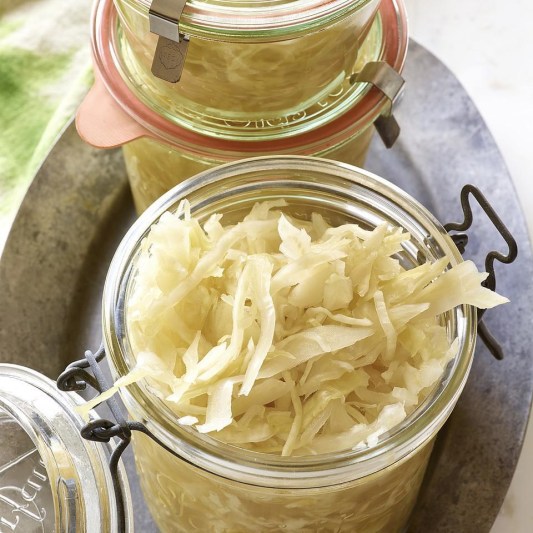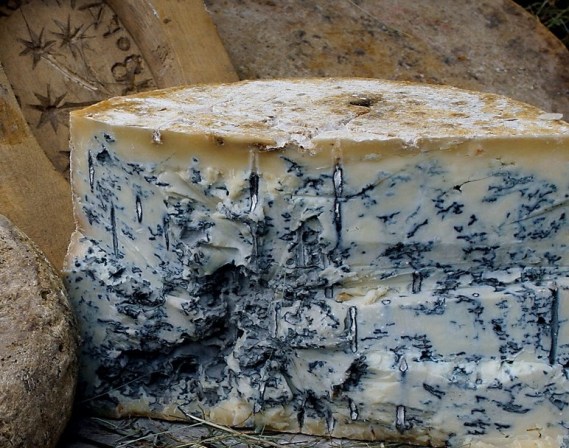
fermentation: an enzymatically controlled anaerobic breakdown of an energy-rich compound (such as a carbohydrate to carbon dioxide and alcohol or to an organic acid)
The heart of fall means making sauerkraut. Fermentation is an easy and nutritious way to preserve fresh vegetables for the coming winter months when the fields are frozen. With the first frost predicted this weekend, it was time to act.
My friend Tom announced he wanted to make sauerkraut, so I gladly procured over 100 pounds and headed to his house where we spent the afternoon shredding away with a wooden Austrian kraut cutter. Unlike an electric food processor, the ultra sharp blades on this wooden washboard-style cutter deliver a thinner cut with longer, feathery strands – something he deemed critical to making good sauerkraut.
We packed our crocks full of the gossamer brassicas, two teaspoons of picking salt for every pound of vegetables, and then topped each container off with several of the large outer leaves set aside earlier as we were splitting the heads. By the time each was two-thirds full, the salt had started to leach moisture from the cabbage shreds, creating a natural brine. This in turn would create the anaerobic environment for fermentation.
For the next six weeks I’ll be checking my crocks daily to make sure the cabbage remains submerged under a plate topped with a gallon jug full of water to keep the kraut submerged and to skim off any scum that has formed on the surface of the liquid. According to Tom, this step is critical otherwise the kraut will begin to rot or at the very least, have an off taste. And my house will develop a distinct odor. It’s been less than a week and I can tell all those little microbes are already hard at work.
Why do humans ferment food? Have you ever stopped to realize how much fermented foods we consume? Think about all the fermented foods you find at Central Farm Markets – pickles, kimchi, krauts, beer, wine, liquor, cider, vinegar, kombucha, charcuterie, cheeses, yogurt and bread. Yes, all those foods in one way or another have been fermented using naturally occurring yeasts and bacteria or have been inoculated with cultures to achieve a specific result.
There are two main types of fermentation – lactic acid and alcoholic. Sauerkraut and kimchi undergo a lactic acid fermentation using only the naturally occurring bacteria from the vegetables. Dairy products and meats require the additional exposure to specific cultures for their fermentations.

All those wonderful cheeses you see have varieties of cultures that create their individual flavors, colors and consistencies. For instance, blue cheeses are inoculated with Penicillium Roqueforti. Those lovely bloomy rind camembert are a veritable ecosystem containing Penicillium camemberti, Geotrichum candidum, Debaryomyces hansenii, and Kluyveromyces lactis all working together, keeping each in check to create color, consistency and flavor.
The white stuff on the outside of salami – you guessed it, good mold. There are many types and strains of cultures added which are good bacteria to outcompete bad bacteria that turn meats rancid.
Forget science fiction, real life has SCOBY molds. Drinks such as kombucha and kefir are fermented from a Symbiotic Culture Of Bacteria & Yeast by means anaerobic fermentation of the yeast’s ethanol, the bacteria’s lactic acids and ethanol oxidation to acetate all happening at the same time. This complex process produces a gelatinous, cellulose-based biofilm called a pellicle on the surface of the liquid. Sometimes referred to as a mushroom, a SCOBY is not related to fungi. Other products utilizing SCOBY molds include vinegar and sourdough starters. Although the yeasts are eating sugars and burping out alcohol, the trace amounts of booze in these naturally fizzy beverages are far lower than those of beer, wine and cider.
And we all know about beer, wine and cider….right?
In addition to preservation, fermentation offers other advantages including increased digestibility, better flavor, safer to eat, more nutritious and lots of probiotics.
According to fermentation guru and author, Sandor Katz, humans have been fermenting food for approximately 12,000 years. “We still do it the same way today,” he said. “Why? Because it works. It’s hard to mess it up.”
